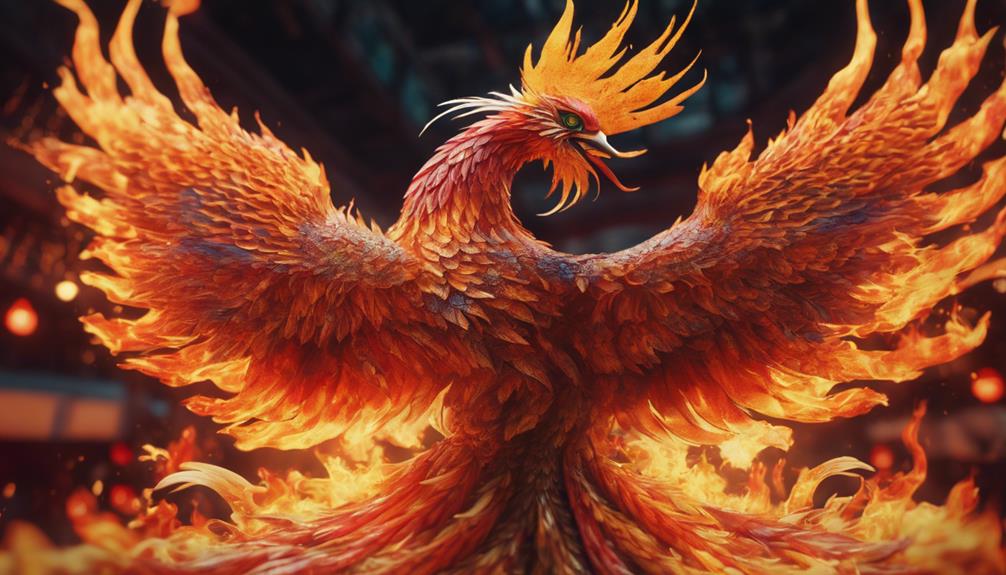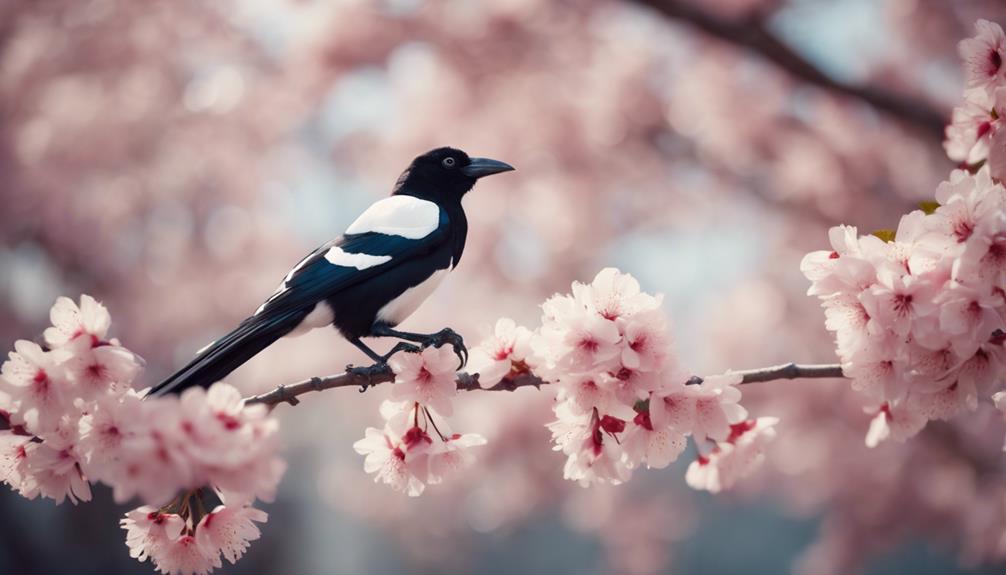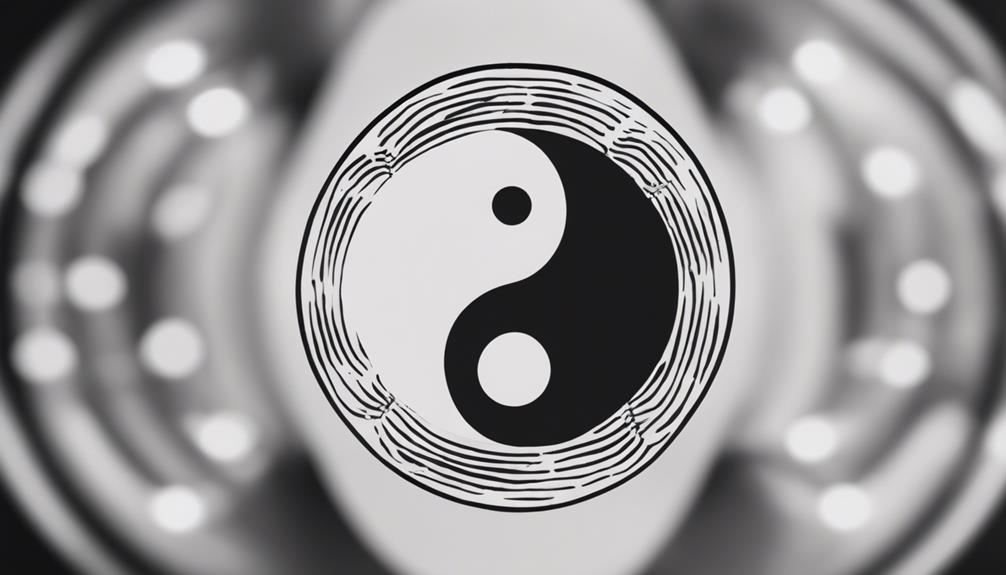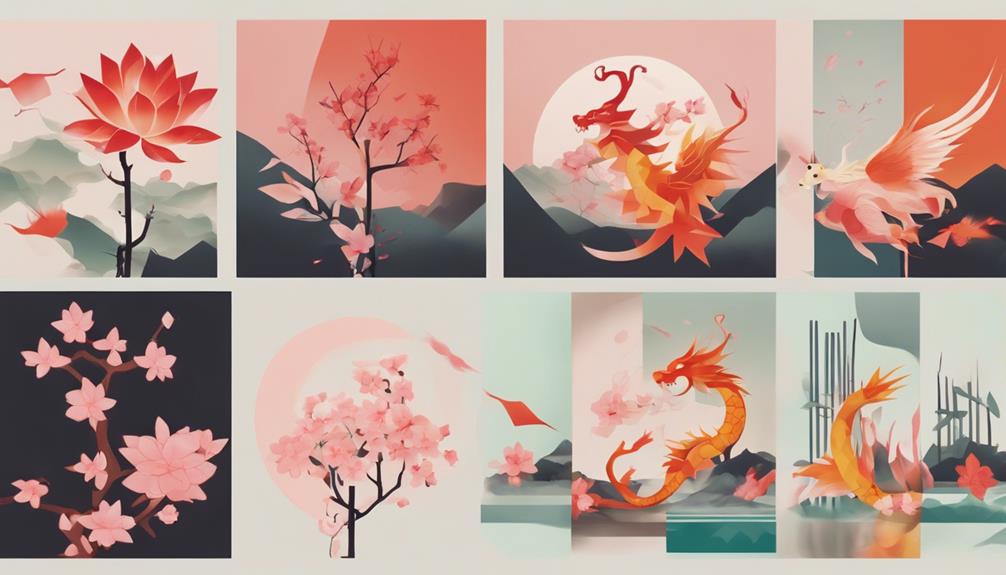When exploring 7 Chinese symbols, you'll discover profound meanings. The dragon signifies power and good luck, while the phoenix symbolizes renewal and balance. Pandas represent harmony and friendship, magpies bring joy and good fortune. Lotuses symbolize purity and beauty emerging from hardship. Bamboo embodies strength, flexibility, and progress. Yin and yang showcase harmony in opposites. Understanding these symbols reveals the beauty of Chinese culture.
Key Takeaways
- Dragon symbolizes power, strength, and good luck, controlling weather for prosperity.
- Phoenix represents renewal, balance, and immortality, embodying feminine power.
- Panda signifies harmony, peace, and wisdom, a national treasure in China.
- Magpie symbolizes joy, happiness, and good fortune, bringing positive energy.
- Lotus flower symbolizes purity, beauty, and spiritual enlightenment, emerging from hardship.
Dragon Symbolism in Chinese Culture
Dragons in Chinese culture symbolize power, strength, and good luck. The Chinese have revered dragons for centuries, embodying these mythical creatures with qualities that inspire awe and respect.
From the elaborate dragon motifs on silk robes worn by emperors to the intricate dragon dances performed during celebrations, the symbolism of dragons runs deep in Chinese tradition. These majestic creatures, often depicted with five claws as a symbol of imperial power, hold a special place in the hearts of the Chinese people.
In Chinese folklore, dragons are believed to have the ability to control the weather, bringing much-needed rain for agricultural abundance. This connection to nature further enhances the dragon's significance in Chinese culture, linking them to prosperity and growth.
The dragon's presence in various aspects of Chinese life reflects the values of strength, power, and good fortune that the Chinese hold dear. Embracing the essence of the dragon symbolism enriches our understanding of Chinese heritage and traditions.
Phoenix Symbolism and Significance

Exploring the symbolism and significance of the phoenix in Chinese culture reveals a rich tapestry of renewal, rebirth, and immortality. The phoenix, a mythical bird, holds deep cultural meaning, embodying harmony, balance, and grace. Here are five key points that shed light on the phoenix symbolism in Chinese symbols:
- Yin and Yang Balance: The phoenix is often paired with the dragon, symbolizing the harmony of yin and yang, showcasing the balance of opposing forces.
- Feminine Power: Associated with the Empress, the phoenix represents feminine power, beauty, and grace in Chinese folklore.
- Auspicious Energy: The phoenix brings auspicious energy, symbolizing high virtue and grace, making it a revered symbol of positivity.
- Renewal and Rebirth: Through its cycles of death and rebirth, the phoenix signifies renewal and the eternal cycle of life.
- Symbol of Immortality: The phoenix's immortality represents the everlasting nature of the soul and the concept of eternal life.
The phoenix is a powerful symbol deeply rooted in Chinese culture, inspiring awe and reverence for its profound meanings.
Panda Symbol: Cultural Representation
The panda symbolizes harmony, peace, and friendship in Chinese culture, embodying virtues that reflect the nation's values and ideals. Pandas are considered a national treasure in China, representing conservation efforts and wildlife protection. Chinese folklore portrays pandas as gentle and wise creatures, embodying virtues like kindness and compassion. The black and white colors of pandas symbolize yin and yang, reflecting balance and harmony in nature. Pandas have been featured in Chinese art, literature, and even as mascots for international events, showcasing their cultural significance.
| Facts about Pandas in Chinese Culture | |
|---|---|
| Pandas symbolize harmony and peace | Pandas are considered a national treasure |
| Pandas represent friendship | Chinese folklore portrays pandas as gentle and wise creatures |
| The black and white colors symbolize yin and yang | Pandas are featured in Chinese art and literature |
Pandas hold a special place in Chinese culture, embodying values of harmony, conservation, and balance. Their presence in art and folklore highlights their significance as symbols of peace and wisdom within Chinese society.
Magpie Symbolism in Chinese Tradition

Symbolizing joy, happiness, and good fortune in Chinese culture, magpies are revered as auspicious birds believed to bring positive energy and luck. In Chinese tradition, these birds hold a significant place, with their presence often associated with good news, prosperity, and a promising future. Here are five key points to understand the deeper meaning behind magpie symbolism in Chinese tradition:
- Magpies are symbols of Chinese good luck, believed to bring happiness and positivity.
- The sight of a magpie is considered a sign of good luck and is welcomed with joy.
- Chinese folklore often portrays magpies as messengers of good news and fortune.
- The presence of magpies is thought to bring about a sense of optimism and bright prospects.
- In Chinese culture, magpies are revered as good luck animals, bringing auspicious energy and blessings to those who encounter them.
Lotus Flower: Spiritual Meaning

With its symbolic representation of purity and spiritual enlightenment, the lotus flower holds profound significance in Chinese culture. The lotus's ability to grow from murky waters and blossom into a beautiful flower signifies beauty emerging from hardship and adversity, making it a powerful symbol of resilience and transformation.
In Chinese culture, the different colors of lotus flowers carry specific meanings – pink symbolizes purity, while red represents passion and love. The lotus is deeply intertwined with Buddhism, where it symbolizes the journey towards enlightenment and self-realization. This exquisite flower isn't only a visual delight but also a spiritual emblem of luck and inner beauty.
Its presence in Chinese art and literature further emphasizes its role as a metaphor for growth and spiritual evolution. The lotus flower serves as a reminder to embrace challenges and emerge stronger, reflecting the essence of Chinese culture's profound spiritual beliefs.
Bamboo Symbol in Chinese Philosophy

Symbolic of strength, flexibility, and resilience in Chinese philosophy, bamboo embodies adaptability and the ability to withstand challenges. This iconic plant holds a profound significance in Chinese culture, representing more than just physical attributes. Here are five deeper meanings associated with the bamboo symbol in Chinese philosophy:
- Growth and Longevity: Bamboo's rapid growth rate symbolizes progress and advancement, while its longevity signifies endurance and lasting impact.
- Grace and Uprightness: The graceful, upright form of bamboo reflects elegance, integrity, and moral character in the face of adversity.
- Simplicity and Humility: Bamboo's simple yet versatile nature teaches the value of humility and the importance of staying grounded despite achievements.
- Harmony with Nature: Bamboo's harmonious existence with its surroundings emphasizes the need for balance and interconnectedness with the environment.
- Cultural Influence: Integrated into art, literature, and daily life, bamboo serves as a constant reminder of the strength and resilience embedded in Chinese heritage.
Yin and Yang: Symbolic Balance

Yin and Yang symbolize the balance in opposing forces, showcasing harmony in duality.
This concept reflects the interconnectedness of life, emphasizing the need for equilibrium between contrasting elements.
Understanding this symbolism can provide insight into the complexity and harmony found in the universe. By examining various cultural and spiritual traditions, we see that the interconnectedness of elements and archetypes reflects deeper truths about existence. For example, the symbolism in race meaning fire can represent the dynamic energy that drives both physical and spiritual transformation. This fiery symbolism often signifies passion, creation, and destruction, embodying the constant cycles of renewal and change present in the cosmos.
Harmony in Opposites
In Chinese philosophy, the concept of Yin and Yang highlights the harmonious balance between opposing forces, emphasizing their interconnectedness and dynamic nature.
- Yin and Yang represent complementary forces in the universe, symbolizing dark/passive versus light/active.
- The symbol is a divided circle with a small dot of the opposite color in each half.
Interconnected and interdependent, Yin and Yang showcase life's dynamic nature and the importance of harmony.
- Aligning Yin and Yang is believed to bring balance, harmony, and positive energy.
- Embracing the duality of Yin and Yang fosters a deeper understanding of the interconnectedness of all things, promoting a holistic approach to life.
Balance and Duality
How do the concepts of balance and duality manifest in the symbolism of Yin and Yang? Yin and Yang represent the interplay of opposite forces in the universe, symbolizing harmony and equilibrium. In Chinese philosophy, Yin is linked to darkness, passivity, and femininity, while Yang embodies light, activity, and masculinity. This duality illustrates the interconnected nature of seemingly contrasting elements, emphasizing the need for balance in all aspects of life. The symbol of Yin and Yang is deeply ingrained in Chinese culture, influencing various practices like traditional Chinese medicine and the Chinese zodiac. Understanding Yin and Yang enables individuals to perceive the interconnectedness of apparently conflicting aspects in the world.
| Yin | Yang |
|---|---|
| Darkness | Light |
| Passivity | Activity |
| Femininity | Masculinity |
Interconnectedness of Life
Emphasizing the interconnectedness of life, the symbol of Yin and Yang embodies a profound concept of balance and harmony in Chinese philosophy and culture.
- Opposing Forces: Yin and Yang symbolize the balance of opposite forces in the universe.
- Harmony in Duality: They represent darkness and light, showcasing the harmony and duality in life.
- Interconnected Elements: The symbol illustrates how seemingly contrasting elements are interconnected and interdependent.
- Feminine and Masculine: Yin symbolizes receptivity, passivity, and the feminine, while Yang represents activity, assertiveness, and the masculine.
- Key to Balance: Understanding Yin and Yang is essential in grasping the concept of balance and harmony in Chinese philosophy, influencing practices like feng shui and inspiring Chinese idioms.
Frequently Asked Questions
What Does 7 Mean in Chinese Culture?
In Chinese culture, the number 7 symbolizes harmony, Tao, kindness, and beauty. It holds significance in ancient Chinese traditions, representing aspects like the Seven Treasures and the Double Seventh Festival.
Despite its propitious nature, the number 7 also carries negative connotations in Chinese history. References such as the July 7th Incident of 1937 highlight the diverse interpretations of this number in Chinese society.
What Are the Most Powerful Chinese Symbols?
The most powerful Chinese symbols encompass the Dragon, Phoenix, Fu Dog, Koi Fish, and Turtle, each representing distinct qualities and bringing good fortune.
Dragons exude power, Phoenixes symbolize renewal, Fu Dogs offer protection, Koi Fish bring success, and Turtles embody wisdom.
Strategically placed in Feng Shui practices, these symbols enhance various aspects of life.
Understanding their meanings and placements allows us to tap into their positive energies for personal growth and prosperity.
What Are Some Symbols That Represent China?
Some symbols that represent China include:
- The dragon, symbolizing power and luck.
- The phoenix for renewal and harmony.
- Pandas embodying peace and friendship.
- Lotus flowers symbolizing strength and purity.
- Magpies signifying joy and good fortune.
These symbols hold deep cultural significance in China and are widely recognized for their positive meanings and associations.
Why Are Chinese Symbols Important?
Chinese symbols are important because they carry centuries-old cultural values and meanings. They serve as a unique form of communication, expressing complex ideas visually. Understanding these symbols deepens our appreciation of Chinese history and traditions.
Conclusion
To sum up, exploring the meanings behind these Chinese symbols reveals a rich tapestry of culture, tradition, and spirituality.
Just like the intricate balance of yin and yang, each symbol holds its own unique significance, offering insights into the deep-rooted beliefs and values of Chinese society.
From the majestic dragon to the delicate lotus flower, these symbols serve as reminders of the interconnectedness of all things in the world around us.











